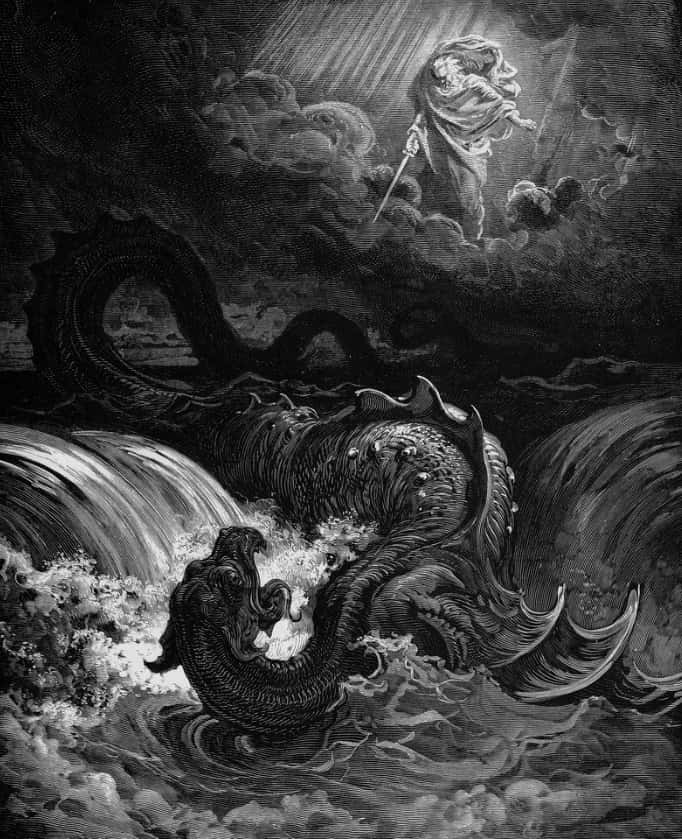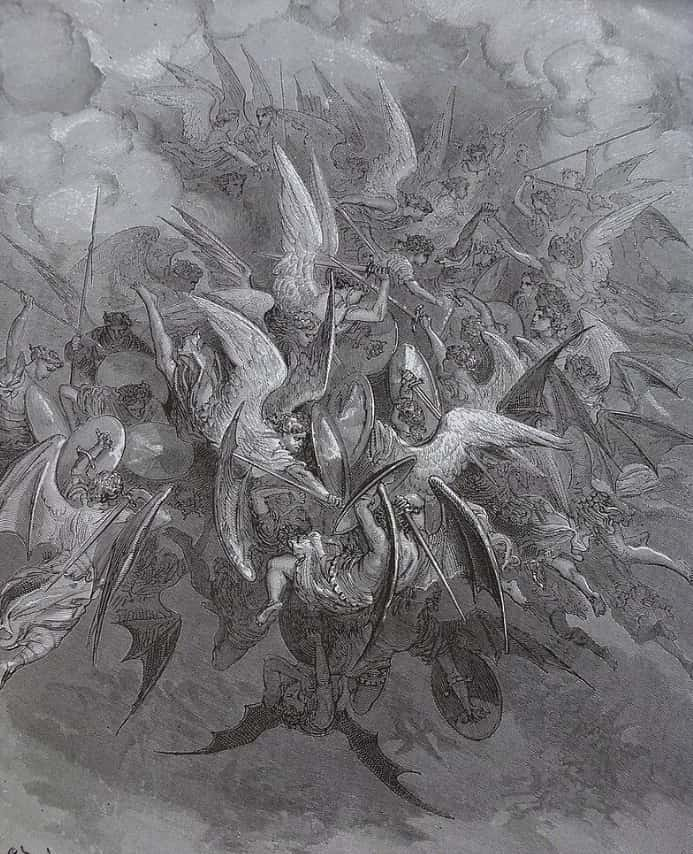The topic of the devil’s appearance is a subject of curiosity and intrigue for many. In this article, we will explore the biblical perspective on the devil’s appearance and seek to answer the question, “What does the Bible say the devil looks like?” Understanding the biblical viewpoint on the devil’s appearance is not only interesting but also holds significant importance for believers.
The devil, also known as Satan, is a central figure in biblical texts and theology. While the Bible does not provide a detailed physical description of the devil, it offers insights into his characteristics, motivations, and tactics. By examining these biblical references, we can gain a better understanding of the devil’s nature and the role he plays in spiritual battles.
Recognizing the biblical perspective on the devil’s appearance is crucial for believers. It allows them to discern the devil’s deception, resist his temptations, and stand firm in their faith. By understanding the devil’s tactics and comparing them with the teachings of the Bible, believers can navigate the spiritual battles they may face and experience victory over the devil’s influence.
Throughout this article, we will explore the biblical descriptions of the devil, examine his characteristics and actions, discuss the significance of recognizing and resisting his influence, and provide insights into the symbolic representations of the devil. By gaining a deeper understanding of the devil’s appearance from a biblical perspective, we can shed light on this intriguing aspect of spiritual warfare. So, let’s dive into the biblical passages and teachings to explore what the Bible says about the devil’s appearance.
| Main Key Points | Summary |
|---|---|
| The Bible’s Perspective | The Bible offers insights into the devil’s characteristics, motivations, and tactics, but does not provide a detailed physical description of his appearance. |
| The Devil’s Role | The devil is a powerful spiritual being who opposes God, deceives, and tempts humanity. |
| Importance of Understanding | Understanding the biblical perspective on the devil’s appearance is crucial for believers to recognize and resist his influence. |
| Contrast with Christ | Comparing the devil’s characteristics with those of Christ highlights God’s goodness and the evil nature of the devil. |
| Recognizing and Resisting | Believers must recognize the devil’s deception, resist his temptations, and engage in spiritual practices to protect themselves. |
Table of Contents
The Devil in the Bible
In the Bible, the devil is a prominent figure who plays a significant role in the spiritual realm and human affairs. Understanding the biblical perspective on the devil’s appearance is crucial for believers seeking to navigate the spiritual battles they may encounter. Let’s explore the biblical references to the devil and gain insights into his characteristics and actions.
Overview of Biblical References
The devil is referred to by various names and titles in the Bible, including Satan, Devil, Evil One, and more. These names emphasize different aspects of his nature and role. Throughout the scriptures, the devil is portrayed as a powerful spiritual being who opposes God and seeks to deceive and tempt humans.
Different Names and Titles
- Satan: This name comes from the Hebrew word “ha-Satan,” which means “the adversary” or “the accuser.” It highlights the devil’s role as an opponent of God and humans.
- Devil: The term “devil” comes from the Greek word “diabolos,” which means “slanderer” or “accuser.” It emphasizes the devil’s deceptive nature and his desire to lead people astray.
- Evil One: This title highlights the devil’s malevolent and evil nature. It signifies his opposition to everything good and godly.
Biblical Passages Describing the Devil
Several biblical passages provide insights into the devil’s characteristics and actions. These passages help us understand the devil’s role in tempting and deceiving humans:
- Matthew 4:1-11: This passage describes the devil’s temptation of Jesus in the wilderness. It illustrates the devil’s cunning tactics and his attempt to divert Jesus from fulfilling his mission.
- 2 Corinthians 11:14: This verse mentions the devil’s ability to disguise himself as an angel of light. It warns believers to be vigilant and discerning, as the devil can appear attractive and persuasive.
- Revelation 12:9: This verse speaks of the devil as the great dragon, the ancient serpent, who deceives the whole world. It highlights the devil’s power of deception and his role in leading humanity astray.
- 1 Peter 5:8: This verse urges believers to be sober-minded and watchful because the devil prowls around like a roaring lion, seeking someone to devour. It emphasizes the devil’s predatory nature and his desire to destroy.
These passages, among others, offer valuable insights into the devil’s characteristics and actions as described in the Bible. Understanding these biblical references helps believers recognize and resist the devil’s influence in their lives.
Biblical Descriptions of the Devil
In the Bible, there are specific descriptions that provide insights into the appearance, nature, and role of the devil. These descriptions help us understand the spiritual being who seeks to deceive and influence human behavior.
Appearance and Nature
While the Bible does not provide a detailed physical description of the devil, it does use symbolic language and imagery to convey his characteristics. The devil is often depicted as a serpent, dragon, or a roaring lion, highlighting his cunning, power, and predatory nature. These descriptions emphasize the devil’s role as a malevolent entity who seeks to lead people astray and oppose God’s plans.

Key Passages
Several key passages in the Bible provide insights into the devil’s physical form and attributes:
- Ezekiel 28:12-19: This passage speaks of the king of Tyre, but it is believed to contain symbolic language referring to the devil. It describes the devil as a beautiful and powerful being who was in Eden, adorned with precious stones. However, his pride led to his downfall, and he became corrupt.
- Isaiah 14:12-15: This passage is often interpreted as referring to the fall of Lucifer, who is equated with the devil. It portrays the devil’s desire to exalt himself above God and his subsequent expulsion from heaven.
- Luke 10:18: In this verse, Jesus says, “I saw Satan fall like lightning from heaven.” While it does not provide a physical description, it signifies the devil’s fall from his original position as an angel.
Spiritual Being and Influence
The devil is portrayed as a spiritual being with the ability to influence human behavior. He is described as a tempter, deceiver, and the father of lies. The devil’s primary goal is to lead people away from God and into sin. He seeks to divide, discourage, and divert believers from their faith.
The devil’s influence on human behavior is seen throughout the Bible, from his temptation of Adam and Eve in the Garden of Eden to his attempts to tempt Jesus during his earthly ministry. The devil uses deceitful tactics to mislead and ensnare individuals, appealing to their desires and weaknesses.
Symbolism and Representations
The devil is often depicted symbolically in biblical texts, artistic representations, and folklore. These various depictions and interpretations have influenced the popular perception of the devil’s appearance. Let’s explore the symbolism and representations associated with the devil.
Symbolic Representations in Biblical Texts
In biblical texts, the devil is symbolically represented in various ways. He is often referred to as a serpent, symbolizing his deceitful and cunning nature. The serpent’s role in tempting Adam and Eve in the Garden of Eden is a significant example of this symbolism. Additionally, the devil is described as a dragon, emphasizing his power and ferocity. These symbolic representations convey the devil’s malevolent nature and his opposition to God’s plans.

Artistic and Visual Representations
Throughout history, artists have depicted the devil in various forms, reflecting cultural and artistic influences. In medieval art, the devil was often portrayed as a grotesque creature with horns, a tail, and a pitchfork. This image conveyed the devil’s association with sin and evil. In contrast, Renaissance and Baroque art sometimes depicted the devil as an attractive figure, highlighting his ability to deceive and allure individuals.
Influence of Folklore and Ancient Mythology
Folklore and ancient mythology have also played a role in shaping the popular perception of the devil’s appearance. The devil’s association with horns, a tail, and a red suit can be traced back to ancient depictions of horned deities and creatures. These influences have contributed to the visual representations of the devil as a goat-like creature with horns and a tail.
Furthermore, folklore and mythology have added layers of complexity to the devil’s character. In some stories, the devil is portrayed as a sympathetic figure or an antihero, challenging traditional notions of good and evil. These alternative portrayals highlight the devil’s complexity and the different interpretations that have emerged throughout history.
Satan’s Deceptive Tactics
The devil, also known as Satan, is a master deceiver and tempter. Understanding his deceptive tactics is crucial for believers in order to recognize and resist his influence. Let’s explore the devil’s role as a deceiver, his tactics to mislead humans, and biblical teachings on recognizing and resisting his deception.
Role as a Deceiver and Tempter
The devil’s primary role is to deceive and lead people away from God’s truth. He disguises himself as an angel of light, presenting appealing and enticing temptations to lure individuals into sin. By distorting the truth and appealing to human desires, the devil seeks to undermine faith and separate people from God.
Tactics to Deceive and Mislead
The devil employs various tactics to deceive and mislead humans. Some of these tactics include:
- Lies and Falsehoods: The devil is a liar and the father of lies. He spreads false teachings, distorts the truth, and creates confusion to lead people astray.
- Temptation: The devil tempts individuals with worldly desires, appealing to their weaknesses and vulnerabilities. He offers immediate gratification and promises of power, wealth, and pleasure.
- Distortion of Scripture: The devil often twists and misinterprets biblical teachings to suit his purposes. He uses Scripture out of context to deceive and mislead.
- False Miracles and Signs: The devil can perform counterfeit miracles and signs to deceive people. These deceptive displays can lead individuals to believe in false doctrines or follow false leaders.
Recognizing and Resisting the Devil’s Deception
The Bible provides guidance on recognizing and resisting the devil’s deception. It teaches believers to:
- Stay rooted in God’s Word: By studying and understanding the Bible, believers can discern the truth and recognize the devil’s lies.
- Seek the guidance of the Holy Spirit: The Holy Spirit helps believers discern between truth and deception. Through prayer and reliance on the Spirit’s guidance, believers can resist the devil’s temptations.
- Put on the full armor of God: Ephesians 6:11-12 instructs believers to put on the full armor of God to stand against the devil’s schemes. This includes the belt of truth, the breastplate of righteousness, the shield of faith, the helmet of salvation, the sword of the Spirit, and the shoes of peace.
- Be vigilant and sober-minded: Believers are encouraged to be watchful and alert, recognizing the devil’s tactics and staying vigilant in their faith.
Contrasts and Comparisons
When examining the devil’s characteristics and motivations, it is helpful to compare and contrast them with those of Christ. By understanding the stark differences between the devil and God, we can gain a deeper appreciation for God’s goodness and the evil nature of the devil. Let’s explore the contrasts and comparisons between the devil and Christ, as well as biblical passages that highlight these distinctions.
Characteristics and Motivations
The devil’s characteristics and motivations stand in stark contrast to those of Christ. The devil is driven by evil intentions, seeking to deceive, tempt, and lead people astray. He is the embodiment of sin and rebellion against God. In contrast, Christ is characterized by love, compassion, and selflessness. His motivations are rooted in righteousness, redemption, and the salvation of humanity.

Evil Nature vs. God’s Goodness
The devil’s evil nature is in direct opposition to God’s goodness. The devil delights in causing harm, promoting division, and sowing discord among people. He seeks to undermine God’s plans and lead humanity away from God’s truth. In contrast, God is inherently good, loving, and just. His nature is characterized by mercy, forgiveness, and the desire for reconciliation with humanity.
Biblical Passages Highlighting the Contrast
Several biblical passages highlight the stark contrast between the devil and God:
- John 8:44: Jesus describes the devil as a liar and the father of lies, emphasizing the devil’s deceitful nature. This passage underscores the contrast between the devil’s falsehoods and Jesus’ truthfulness.
- 1 John 4:8: The apostle John states that “God is love.” This passage highlights God’s essential nature of love, which stands in direct opposition to the devil’s malevolence.
- James 4:7: This verse encourages believers to submit to God and resist the devil. It emphasizes the need to align oneself with God’s goodness and resist the devil’s temptations.
These passages, among others, emphasize the contrasting nature of the devil and God. They highlight the vast difference between the devil’s motivations and the character of Christ. Understanding these distinctions helps believers recognize the evil nature of the devil and appreciate the goodness and love of God.
Spiritual Warfare and Protection
Believers are engaged in a spiritual battle against the devil and his influence. Understanding the concept of spiritual warfare and implementing biblical teachings on protection are essential for navigating this battle. Let’s explore the concept of spiritual warfare, biblical teachings on protecting oneself against the devil’s influence, and the importance of spiritual practices such as prayer and wearing the full armor of God.
Concept of Spiritual Warfare
Spiritual warfare refers to the ongoing battle between good and evil in the spiritual realm. Believers are called to actively engage in this battle, recognizing that they are not fighting against flesh and blood but against spiritual forces of evil. The devil, as the adversary, seeks to deceive, tempt, and hinder believers in their faith.
Protecting Oneself against the Devil’s Influence
The Bible provides teachings on how believers can protect themselves against the devil’s influence:
- Put on the Full Armor of God: Ephesians 6:11-12 instructs believers to put on the full armor of God to stand against the devil’s schemes. This armor includes the belt of truth, the breastplate of righteousness, the shield of faith, the helmet of salvation, the sword of the Spirit, and the shoes of peace. Each piece represents a spiritual attribute or practice that helps protect against the devil’s attacks.
- Stay Firm in Faith: James 4:7 encourages believers to submit to God, resist the devil, and he will flee. By remaining steadfast in faith and relying on God’s strength, believers can overcome the devil’s influence.
- Seek God’s Guidance: Prayer is a powerful spiritual practice that connects believers with God’s wisdom and protection. By regularly seeking God’s guidance through prayer, believers can stay aligned with His will and receive the strength to resist the devil’s temptations.
- Study and Meditate on God’s Word: The Bible is a source of truth and guidance. By studying and meditating on God’s Word, believers gain a deeper understanding of His teachings and are better equipped to discern the devil’s deceptions.
Importance of Spiritual Practices
Engaging in spiritual practices is vital for believers to protect themselves against the devil’s influence. Prayer, wearing the full armor of God, studying God’s Word, and seeking His guidance help believers stay connected to God’s power and discern the devil’s tactics. These practices strengthen their faith, provide wisdom, and enable them to resist the devil’s temptations.
Recognizing the Devil’s Influence
The devil employs various tactics to divide, discourage, and divert believers from their faith. Recognizing the devil’s deception and evil motivations is crucial for believers to stay vigilant and resist his influence. Let’s explore the devil’s tactics, how to identify his deception and evil motivations, and biblical teachings on discerning the devil’s influence in one’s life.
Tactics to Divide, Discourage, and Divert
The devil seeks to divide believers by sowing discord, promoting conflicts, and creating divisions within the community of faith. He aims to discourage believers by attacking their faith, causing doubt, and tempting them to give up. Additionally, the devil tries to divert believers from their spiritual journey by enticing them with worldly desires and distractions.
Identifying the Devil’s Deception and Evil Motivations
To identify the devil’s deception and evil motivations, it is essential to be aware of his tactics and compare them with God’s truth. The devil often distorts the truth, promotes lies, and appeals to human desires and weaknesses. He may try to deceive by masquerading as an angel of light or by twisting biblical teachings. By comparing his actions and motivations with the teachings of the Bible, believers can discern the devil’s deception and evil intentions.
Biblical Teachings on Discerning the Devil’s Influence
The Bible provides guidance on discerning the devil’s influence in one’s life. It encourages believers to:
- Stay rooted in God’s Word: Regularly studying and meditating on the Bible helps believers develop discernment and recognize the devil’s deceitful tactics.
- Seek the guidance of the Holy Spirit: The Holy Spirit provides wisdom and discernment. By cultivating a relationship with the Holy Spirit through prayer and surrender, believers can discern the devil’s influence.
- Surround themselves with fellow believers: Being part of a supportive community of faith allows believers to receive guidance, encouragement, and accountability in recognizing and resisting the devil’s influence.
- Test the spirits: 1 John 4:1 advises believers to test the spirits to see if they are from God. This involves examining teachings, actions, and motivations against the truth of God’s Word.
The Devil’s Defeat
The Bible narrates the ultimate defeat of the devil through the sacrifice of Jesus Christ. Understanding this narrative and the significance of Jesus’ blood in overcoming the devil’s power is essential for believers. Let’s explore the biblical narrative of the devil’s defeat, the significance of Jesus’ blood, and biblical teachings on the devil’s ultimate defeat and the victory of Christ.

Biblical Narrative of the Devil’s Defeat
The biblical narrative reveals that through Jesus’ death and resurrection, the devil’s power and hold over humanity were ultimately defeated. Jesus willingly sacrificed Himself on the cross to redeem humanity from sin and reconcile them with God. His victory over sin and death shattered the power of the devil, who had held humanity captive.
Significance of the Blood of Jesus
The blood of Jesus holds significant meaning in overcoming the devil’s power. In biblical times, blood represented life and was often associated with sacrifice and atonement. Jesus’ blood, shed on the cross, signifies the sacrificial offering that cleanses believers from sin and breaks the power of the devil. It is through Jesus’ blood that believers find forgiveness, redemption, and victory over the devil’s influence.
Biblical Teachings on the Devil’s Ultimate Defeat and the Victory of Christ
The Bible teaches that the devil’s ultimate defeat and the victory of Christ are assured. Several passages highlight this truth:
- Colossians 2:15: This verse declares that Jesus disarmed the powers and authorities, making a public spectacle of them through His victory on the cross.
- Revelation 20:10: This passage speaks of the devil’s ultimate destiny, being thrown into the lake of fire, where he will be tormented forever.
- 1 John 3:8: The apostle John affirms that Jesus came to destroy the works of the devil, emphasizing the triumph of Christ over the devil’s schemes.
These teachings assure believers that the devil’s defeat is certain and that they can live in the victory of Christ. By placing their faith in Jesus and His redemptive work, believers can experience freedom from the devil’s power and the assurance of eternal life.
Related: What Are Biblically Accurate Angels
Conclusion
In conclusion, we have explored various aspects of the devil’s appearance, nature, and influence as depicted in the Bible. Throughout the article, we discussed the biblical references to the devil, his characteristics, and his deceptive tactics. We examined the symbolic representations of the devil, both in biblical texts and artistic depictions. Additionally, we highlighted the importance of recognizing and resisting the devil’s influence in one’s life.
Understanding the biblical perspective on the devil’s appearance is crucial for believers. It allows them to discern the devil’s deception, resist his temptations, and stand firm in their faith. By comparing the devil’s characteristics with those of Christ, believers gain a deeper appreciation for God’s goodness and the evil nature of the devil. Recognizing the devil’s tactics to divide, discourage, and divert believers helps believers stay vigilant and protect their faith.
Throughout the article, we emphasized the significance of spiritual warfare, protection, and discernment in recognizing and resisting the devil’s influence. By engaging in spiritual practices such as prayer, wearing the full armor of God, and studying God’s Word, believers can fortify their faith and overcome the devil’s schemes.
FAQ
What are the tactics that the devil uses to deceive and mislead humans?
The devil employs tactics such as spreading lies and falsehoods, tempting individuals with worldly desires, and distorting the truth to lead people astray.
How is the devil portrayed in the Bible?
The devil is portrayed as a powerful spiritual being who opposes God, deceives, and tempts humanity. He is often symbolically represented as a serpent, a dragon, or a roaring lion

As a passionate scholar of theology, angelology, and biblical studies, I, Chandra Dona, am dedicated to the exploration of the celestial and divine realms as mentioned in various scriptures. I am an author committed to inspiring thoughtful discourse and fostering a deeper understanding and appreciation of our spiritual heritage, through rigorous academic exploration and engaging writings on the complex and beautiful aspects of belief.






